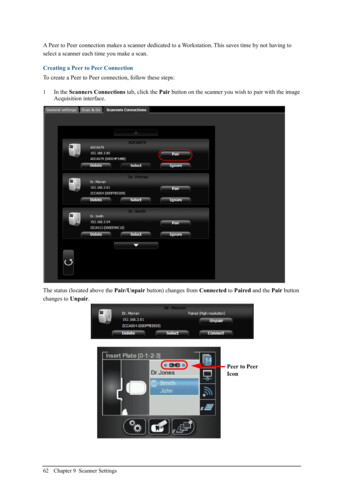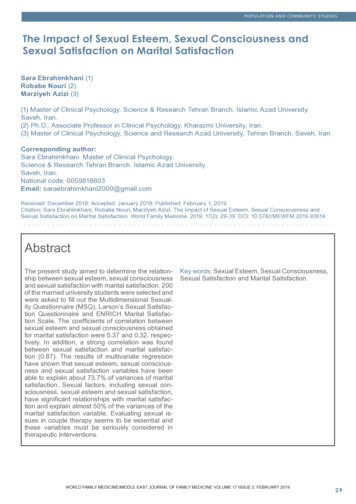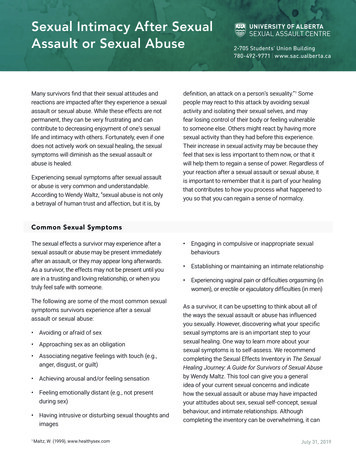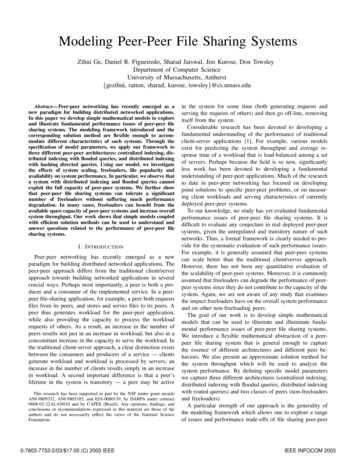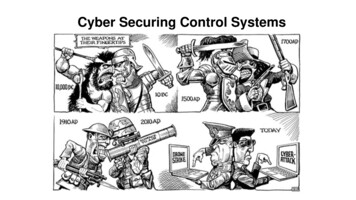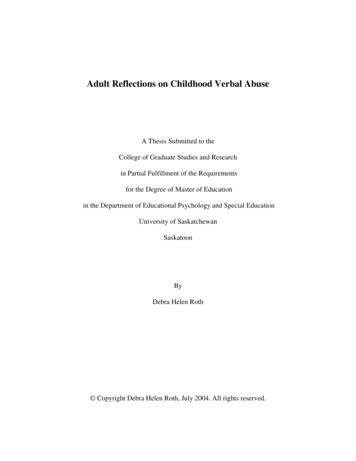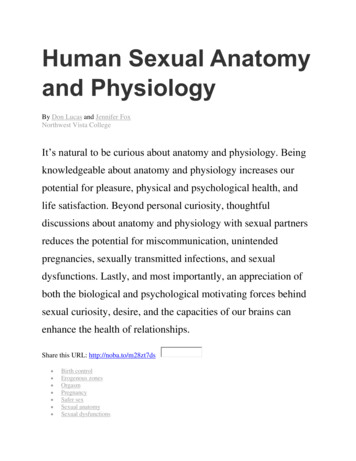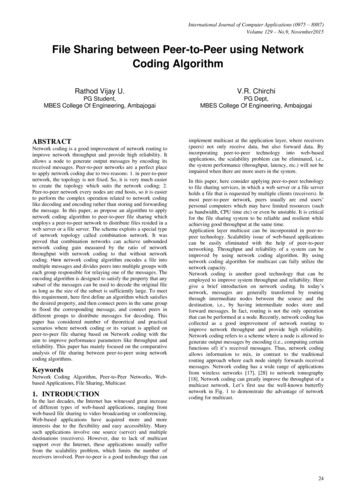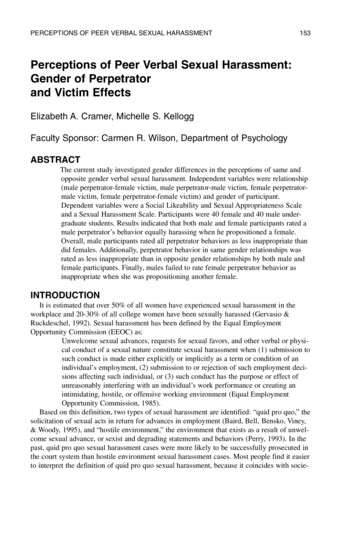
Transcription
PERCEPTIONS OF PEER VERBAL SEXUAL HARASSMENT153Perceptions of Peer Verbal Sexual Harassment:Gender of Perpetratorand Victim EffectsElizabeth A. Cramer, Michelle S. KelloggFaculty Sponsor: Carmen R. Wilson, Department of PsychologyABSTRACTThe current study investigated gender differences in the perceptions of same andopposite gender verbal sexual harassment. Independent variables were relationship(male perpetrator-female victim, male perpetrator-male victim, female perpetratormale victim, female perpetrator-female victim) and gender of participant.Dependent variables were a Social Likeability and Sexual Appropriateness Scaleand a Sexual Harassment Scale. Participants were 40 female and 40 male undergraduate students. Results indicated that both male and female participants rated amale perpetrator’s behavior equally harassing when he propositioned a female.Overall, male participants rated all perpetrator behaviors as less inappropriate thandid females. Additionally, perpetrator behavior in same gender relationships wasrated as less inappropriate than in opposite gender relationships by both male andfemale participants. Finally, males failed to rate female perpetrator behavior asinappropriate when she was propositioning another female.INTRODUCTIONIt is estimated that over 50% of all women have experienced sexual harassment in theworkplace and 20-30% of all college women have been sexually harassed (Gervasio &Ruckdeschel, 1992). Sexual harassment has been defined by the Equal EmploymentOpportunity Commission (EEOC) as:Unwelcome sexual advances, requests for sexual favors, and other verbal or physical conduct of a sexual nature constitute sexual harassment when (1) submission tosuch conduct is made either explicitly or implicitly as a term or condition of anindividual’s employment, (2) submission to or rejection of such employment decisions affecting such individual, or (3) such conduct has the purpose or effect ofunreasonably interfering with an individual’s work performance or creating anintimidating, hostile, or offensive working environment (Equal EmploymentOpportunity Commission, 1985).Based on this definition, two types of sexual harassment are identified: “quid pro quo,” thesolicitation of sexual acts in return for advances in employment (Baird, Bell, Bensko, Viney,& Woody, 1995), and “hostile environment,” the environment that exists as a result of unwelcome sexual advance, or sexist and degrading statements and behaviors (Perry, 1993). In thepast, quid pro quo sexual harassment cases were more likely to be successfully prosecuted inthe court system than hostile environment sexual harassment cases. Most people find it easierto interpret the definition of quid pro quo sexual harassment, because it coincides with socie-
154CRAMER AND KELLOGGtal norms, which stress that advancement in employment should be based on merit alone.Hostile environment harassment appears to be less clear to people because there are oftendiscrepancies about what constitutes a hostile environment. For instance, some people findjokes with a sexual content to be sexually harassing, while others see sexual jokes to be partof normal interaction in the work or school setting (Baird, et al., 1995). Therefore, a compelling research area is to empirically understand individual’s perceptions of what constituteshostile environment sexual harassment.It is also important to explore perceptions of hostile environment because current legalstandards (as set by the United States Supreme Court) determine whether or not an incidentis sexual harassment by using the “reasonable” person standards. In other words, would thereasonable person find this incident to be sexually harassing. Recently in lower court cases,the “reasonable woman” standard has been used in determining if indeed the incident couldlegally be classified as sexual harassment. The reasonable woman standard takes into accountthe gender of the victim because research has established the existence of large gender differences in perceptions of hostile environment sexual harassment situations (Baird, et al., 1995).Therefore, studies of perception of sexual harassment may serve to further establish reasonable woman standards.Past research indicates that women are more likely to label various behaviors as sexualharassment than men are. For instance, women are more likely than men to consider sexualteasing, jokes, looks, and gestures, as well as remarks from co-workers, to be sexual harassment (Padgitt & Padgitt, 1986; Powell, 1986). Dietz-Uhler and Murrell (1992) found thatmales felt more strongly than females that “people should not be so quick to take offensewhen a person expresses sexual interest in them.” In their study, men were also more likelythan women to believe that sexual harassment is overblown in today’s society and that ittakes place in business settings more often than in school settings.Although research tends to focus on harassment where the perpetrator is male and the victim is female, some studies have reported that males are frequent victims of sexual harassment. Mazer and Percival (1989), found that 89% of women and 85.1% of men reported atleast one incident of sexual harassment. In addition, males reported an average of 5.6 incidents of sexual harassment in college, and females reported an average of 6.2 incidents ofsexual harassment in college. These statistics merit the need for further investigation regarding male victimization in sexual harassment. Another more recent area of focus byresearchers is same-gender sexual harassment. Whitley (1998) reported that both heterosexual men and women rated their anticipated response to a sexual advance by someone of thesame gender as being highly negative.Finally, most of the past research on hostile environment sexual harassment in universitysettings has focused on faculty-student sexual harassment. However, while 27% of participants reported receiving seductive remarks about their appearance, body, or sexual activitiesfrom professors, 44% of participants reported experiencing these types of remarks fromanother student (Daun, Hellenbran, Limberg, Oyster, & Wolfgram, 1993). High incidence ofpeer sexual harassment suggests that universities need to be more concerned with studentstudent sexual harassment.The current study investigates differences in perceptions of student-student verbal sexualharassment based on gender. We will examine three central hypotheses: 1. Male participantswill view a male’s harassment of a female less negatively than will female participants 2.Male participants will view a female’s sexual harassment of a male less negatively than will
PERCEPTIONS OF PEER VERBAL SEXUAL HARASSMENT155female participants and 3. Both male and female participants will view same-gender sexualharassment as highly negative.METHODParticipantsParticipants were 80 (40 male, 40 female) undergraduate students enrolled in introductorypsychology classes at a medium sized midwestern university. The distribution of participant’sages was positively skewed with ages ranging from 18-42 (median 19.00, mean 19.74,s 3.03). The majority of the participants were Caucasion (97.5%) with the remaining participants equally distributed between Hispanic and Asian/Pacific Islander (1.3% each). Themajority of the participants were underclassmen (freshman 30%, sophomore 52.5%, junior 15.0%, and senior 2.5%).Materials and ProcedureParticipants were told the study was investigating perceptions of interpersonal communication. Specifically, participants were told they would be watching a videotaped interactiontwo times. Before the first viewing, participants were instructed simply to familiarize themselves with the video. Before the second viewing, participants were instructed to watch forbehaviors indicating that the actors were paying attention to each other. The video depictedtwo college students having a conversation while waiting in line for a cash machine. Thevideo taped scenarios varied only in terms of the relationship (male perpetrator-female victim, male perpetrator-male victim, female perpetrator-male victim, female perpetrator-femalevictim).After viewing the videotape, participants completed a questionnaire comprised of itemsbased on previous research. Items measuring sexual appropriateness were embedded withinitems measuring other aspects of interpersonal interaction. The final two items of the questionnaire asked participants to rate the degree to which the situation and the perpetrator’sbehavior were sexually harassing. These two items were presented on a separate page to prevent students from recognizing the true nature of the study. Each item was answered on a linescale where participants marked a line with a slash indicating their degree of agreement. APrinciple Axis Factor Analysis was used to extract a single factor from all administered itemsexcept the sexual harassment items. Items which loaded at .50 and above were retained.These items measured the degree to which the perpetrator’s behavior was inconsiderate,insulting, promiscuous, disrespectful, unintelligent, flirtatious, inappropriate, unlikable, tasteless, and based on sexual attraction. This factor was therefore labeled Social Likeability andSexual Appropriateness Scale (SLSA). Coefficient alpha of this scale was .88. The two itemsmeasuring sexual harassment were combined to form a sexual harassment scale; coefficientalpha was .76.RESULTSData were analyzed using General Linear Model ANOVAs with the SLSA and the sexualharassment scale as dependent variables. The ANOVA entering the SLSA scale as thedependent variable indicated an interaction between gender of participant and relationship(see Table 1). Tukey’s post hoc analysis indicated that the same gender relationships (maleperpetrator-male victim and female perpetrator-female victim) were rated as least inappropriate by the opposite gender participants. Alternatively opposite gender relationships were rated
156CRAMER AND KELLOGGas most inappropriate when the perpetrator was the same gender as the participant (seeFigure 1). Interestingly males’ ratings of the female perpetrator-female victim relationshipwere below the midpoint of the SLSA scale. In other words, males did not find the femaleperpetrator’s behavior to be inappropriate when she was propositioning another female. Allother groups’ ratings were above the midpoint of the SLSA scale. In other words, both malesand females rated the perpetrator’s behavior as inappropriate in all other relationships. TheANOVA entering the sexual harassment scale as the dependent variable also indicated a maineffect of relationship. Males rated all perpetrators’ behaviors as less inappropriate than didfemales. In addition, both males and females rated the perpetrator’s behavior in the samegender relationships as less inappropriate than in the opposite gender relationships, howeverthis should be interpreted with caution due to the gender of participant by relationship interaction effect.Table 1. Mean Ratings on Social Likeability and Sexual Appropriateness ScaleRelationshipMale Perpetrator-Male VictimMale Perpetrator-Female VictimFemale Perpetrator-Female VictimFemale Perpetrator-Male Victim1aParticipant Gender 1Male Mean(s)Female mean(s)63.76 b, c57.70 a, b(11.59)(17.31)83.92 d81.94 c, d(11.08)(11.46)67.62 b, c, d43.69 a(11.62)(15.99)75.56 b, c, d84.45 d(14.48)(8.70)All scores based on a 10 item line scale anchored at 0 cm strongly disagree and 11.2 cm strongly agreeMeans with the same subscript are not differentFigure 1. Mean SocialLikability and SexualAppropriateness Ratingsby Gender of Participantand Relationshipa M MaleP PerpetratorF FemaleV Victim
PERCEPTIONS OF PEER VERBAL SEXUAL HARASSMENT157The second ANOVA entering the sexual harassment scale as the dependent variable indicated a main effect of relationship in that a male propositioning a female was rated significantly more harassing than the perpetrator’s behavior in either of the same gender relationships, regardless of participant gender. Ratings of a female propositioning a male were notdifferent from the other three groups (see Table 2)Table 2. Mean Ratings on Sexual Harassment ScaleRelationshipMale Perpetrator-Male VictimMean Sexual Harassment Rating mean(s)11.43 a(6.80)Male Perpetrator-Female Victim17.46 b(4.29)Female Perpetrator-Female Victim10.26a(7.33)Female Perpetrator-Male Victim13.31 a,b(4.82)1aAll scores based on a two item line scale anchored at 0 cm strongly disagree and 11.2 cm strongly agreeMeans with the same subscript are not differentDISCUSSIONContrary to previous research, men and women did not differ in their overall ratings of thedegree to which the perpetrator’s behavior was sexually harassing. This would suggest that a“reasonable women” standard of sexual harassment would not necessarily differ from a “reasonable person” standard. Also, contrary to the first hypothesis, men and women did not differ in their ratings of a male propositioning a female.Much of the past research has focused on sexual harassment in the workplace (e.g. Gutek& Dunwoody, 1987; Padgitt & Padgitt, 1986; & Powell, 1986). It is possible that student perceptions of interactions change dependent upon setting. Research regarding sexual harassment in a university setting has typically focused on faculty harassment of a student (e.g.Daun, et al., 1993). Again, students may feel quite differently about a situation in which apeer is harassing another peer. Finally, much of the research used a within-subjects designwhere participants would read several vignettes. Participants would then rate the degree towhich the behavior depicted in the vignette was insulting, inappropriate, and sexually harassing (e.g. Katz, Hannon, & Whitten, 1996; and Popovich, Gehlauf, Jolton, Everton, Godinho,Mastrangelo, & Somers, 1996). The demand characteristics of such methodology mayaccount for rating differences between genders. Finally, all of the previous research to datehas used written scenarios to describe the sexually harassing activity. The current researchused a more externally valid method of having participants view a video-taped interaction.The script used in the video had been previously rated by participants in a pilot study asmoderately sexually harassing. Therefore the variability in responses was greater than insome of the previous research where the purpose of the research was more obvious to participants.
158CRAMER AND KELLOGGConsistent with the second hypothesis, men’s ratings of the degree to which the femaleperpetrator’s behavior was sexually harassing or inappropriate when she was propositioninganother female were lower than women’s ratings of the same situation. In fact, men did notfind that situation to be sexually harassing or socially inappropriate as evidenced by a meanbelow the midpoint of the scale.Finally, consistent with the third hypothesis, men and women found same gender scenarios, respective to their own gender, to be more harassing. Therefore, participant responses tothe interactions presented in the current research match participant anticipated responses inprevious research. Whitley (1988) found that heterosexual men and women anticipated feeling highly negative if sexually harassed by a person of the same gender. The reasons formore negative responses remain unclear. It is likely that homophobia, or uncomfortable feelings regarding gay/lesbian/bisexual behavior, may in part influence a person’s reactions tosame gender sexual harassment. Future research should include measures of homophobia ascovariates to determine if participants continue to rate same gender sexual harassment asmore socially and sexually inappropriate over and above what can be accounted for by homophobia itself.The results of this study may aid educators in understanding students’ perceptions ofbehaviors. With this information, university personnel will be able to implement programsthat address questionable behaviors. Universities need to further educate students regardingsexual harassment legal standards and ramifications of sexual harassment.ACKNOWLEDGEMENTSWe would like to thank Dr. Carmen Wilson VanVoorhis and Dr. Betsy L. Morgan for all oftheir guidance, support, and patience with our project. We learned so much, thank you. Also,we would like to thank the UW-L Undergraduate Research Program for giving us this opportunity to conduct our research through their financial support.REFERENCESBaird, C.L., Bensko, N.L., Bell, P.A. Viney, W., and Woody, W.D. (1995). Gender influenceon perceptions of hostile environment sexual harassment. Psychological Reports, 77, 7982.Daun, S., Hellenbrand, A., Limberg, H., Oyster, C.K., Wolfgram, J. (1993). Summary ofUWL sexual harassment survey. Unpublished manuscript, University of Wisconsin-LaCrosse.Dietz-Uhler, B., & Murrell, A. (1992). College students’ perceptions of sexual harassment:Are gender differences decreasing? Journal of College Student Development, 33, 540546.Equal Employment Opportunity Commission. (1986). Guidelines on Discrimination Becauseof Sex, 29 C.F.R. & 1604.11, 25 C.F.R. & 700.561. Cited in: Journal of College StudentDevelopment, 34, 406-410.Gervasio, A.H., & Ruckdeschel, K. (1992). College students’ judgements of verbal sexualharassment. Journal of Applied Social Psychology, 22, 190-211.Gutek, B.A., & Dunwoody, V. (1987). Understanding sex in the workplace. Women andwork: An annual review. Beverly Hills, CA: Sage.
PERCEPTIONS OF PEER VERBAL SEXUAL HARASSMENT159Katz, R.C., Hannon, R., and Whitten, L. (1996). Effects of gender ad situation on the perception of sexual harassment. Sex Roles, 34, 35-42.Mazer, D.B., & Percival, E.F. (1989). Students’ experiences of sexual harassment at a smalluniversity. Sex Roles, 20, 1-22.Padgitt, S.C., & Padgitt, J.S. (1986). Cognitive structure of sexual harassment: Implicationsfor university policy. Journal of College Student Personnel, 27, 34-39.Perry, N.W. (1993). Sexual harassment on campus: Are your actions actionable? Journal ofCollege Student Development, 34, 406-410.Popovich, P.M., Gehlauf, D.N., Jolto, J.A., Everton, W.J., Godinho, R.M., Mastrangelo, P.M.,and Somers, J.M. (1996). Physical attractiveness and sexual harassment: Does every picture tell a story or every story draw a picture? Journal of Applied Social Psychology, 26,520-542.Powell, G.N. (1986). Effects of sex role identity and sex on definitions of sexual harassment.Sex Roles, 14, 9-19.Whitley, B.E. (1988). Sex differences in heterosexuals’ attitudes toward homosexuals: Itdepends upon what you ask. Journal of Sex Research, 24, 287-291.
160
teasing, jokes, looks, and gestures, as well as remarks from co-workers, to be sexual harass-ment (Padgitt & Padgitt, 1986; Powell, 1986). Dietz-Uhler and Murrell (1992) found that males felt more strongly than females that "people should not be so quick to take offense when a person expresses sexual interest in them."

